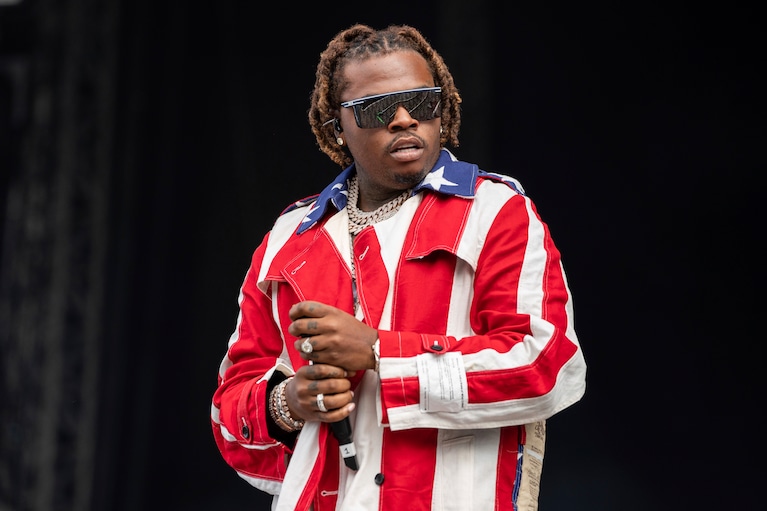Can rappers be jailed for lyrics and image? History shows they can
In this case, Young Thug’s and Gunna’s artistic choices, like lyrics and social media posts, can be used as evidence in court.

On May 9, police arrested Atlanta rapper Young Thug (Jeffery Lamar Williams) and raided his home. Citing journalist Michael Seiden, Complex News reported that Thug was “charged with conspiracy to violate the Racketeer Influenced and Corrupt Organizations Act (RICO) and participation in criminal street gang activity.”
On May 11, rapper Gunna (Sergio Giavanni Kitchens) turned himself in. The rappers are two of 28 individuals named in an indictment of the Young Slime Life or Young Stoner Life (YSL) record label, which authorities call a gang.
YSL rapper Lil Keed (Raqhid Jevon Render), 24, died on May 13 in Los Angeles. The cause of his death is unknown.
Charges against YSL include murder, assault and additional racketeering-related offenses. Specifically, the indictment claims YSL protected and enhanced “the reputation, power and territory” of a criminal enterprise by posting messages, images and videos that displayed “a willingness to engage in violence.”
The indictment accuses YSL of involvement with the Bloods gang, in part through the use of “colors, clothing, tattoos, and hand signs, as well as verbal and written identifiers.”
In this case, Young Thug’s and Gunna’s artistic choices, like lyrics and social media posts, can be used as evidence in court.
This is not the first time art has been a key element in a criminal case involving a Southern rapper at the peak of his career. In the late 1990s, McKinley “Mac” Phipps was a young artist signed to Master P’s No Limit Records. Phipps’s case exposed that law enforcement can misunderstand rap music and culture — and then misuse both to prosecute artists.
The story of No Limit Records began at the Calliope public housing complex in New Orleans. A product of the New Deal, Calliope was initially promoted as a safe choice for families. The city invested in the neighborhood by building a gym in 1949 and additional units in 1954.
But by the 1980s, with the introduction of crack cocaine, residents confronted the problems of addiction and violent crime. With the rise of the war on drugs, residents were met with the increasing presence of law enforcement. As residents began recording rap music, interactions with crime, drugs, and police shaped their sound and the scene surrounding it.
The work of three Calliope residents and brothers — Silkk the Shocker (Vyshonn King Miller), C-Murder (Corey Miller) and Master P (Percy Miller) — was at the heart of this scene. After a few years in California, Master P launched the New Orleans iteration of No Limit Records in 1995. The label’s eclectic sound combined the new West Coast style of rap, influenced by artists like Snoop Dogg, with genres like bounce, a strain of New Orleans club music.
As Master P established himself as a businessman, he and C-Murder never left Calliope behind. Among other charitable ventures, the brothers provided residents with school supplies and food. C-Murder also made the documentary “Straight From the Projects” (2004), which told the story of No Limit’s rise against the backdrop of life in the 3rd Ward of New Orleans. The documentary shows salesmen advertising life insurance for children and gun violence breaking out at a second line parade.
As C-Murder demonstrates, violence was part of life and had an outsize influence on the music of No Limit artists, exemplified by lyrics to songs like Phipps’s “Soldier Party” (1998) and “We Deadly” (1999). No Limit artists often claimed the identity of soldiers and compared their surroundings to war zones, drawing from both their life experiences and military elements.
Phipps joined No Limit in 1996 after competition from multiple labels. Known as the “New Orleans Nas,” Phipps put out his first record at 13, debuting an unprecedented style that combined musical production influenced by New York rap with lyrics commenting on the world around him in New Orleans.
Though he did not grow up in Calliope, Phipps’s lyrics drew from violent memories similar to those of Master P and his brothers. He drew from and made original contributions to No Limit’s brand, which featured references to self-reliance and militarylike discipline.
Phipps’s lyrics and artistic persona made him a law enforcement target. In 2001, he was convicted of manslaughter in the fatal shooting of 19-year-old Barron Victor Jr.
In court, the prosecution quoted lyrics from Phipps’s song “Murda, Murda, Kill, Kill” to persuade the jury to convict, arguing that violent lyrics indicated violent actions.
The prosecution also mentioned one of Phipps’s monikers, “The Camouflage Assassin.” After joining No Limit, Phipps referred to the name in songs and wore camouflage in photos.
Yet prosecutors ignored how it fit within No Limit’s brand. The label’s logo was a tank — a tribute to Master P’s grandfather, who was a veteran. Along with alluding to the military in her lyrics, No Limit rapper Mia X also wore camouflage in 1997 for Source Magazine. In 1998, Master P even released an action figure of himself, wearing his trademark chain and camouflage.
But the state’s strategy to use rap music and fashion choices to win its case was successful. The jury convicted Phipps without direct evidence and despite failing to reach a unanimous verdict — something the Supreme Court made illegal in 2020.
In 2021, Louisiana Gov. John Bel Edwards (D) granted Phipps clemency as a result of public pressure after a video surfaced in 2016 showing another man confessing to the shooting. The state of Louisiana has yet to exonerate Phipps.
After his release, Phipps explained that while his songs and fashion technically could not legally count as evidence, the prosecution nonetheless exploited his art to “paint a character of [him]” that urged the jury to convict.
Phipps’s case holds warnings about the indictments against Young Thug and Gunna — particularly the references to words, colors and even emoji in the charges.
This indicates that prosecutors may again use art and image to demonstrate intent.
Law enforcement may again seek to portray rappers’ lyrics as proof of violent acts, rather than as artistic representations or social commentary on violence.
As Gunna argued recently in a June 14 statement, “My art is not allowed to stand alone as entertainment, I’m not allowed that freedom as a Black man in America.”


